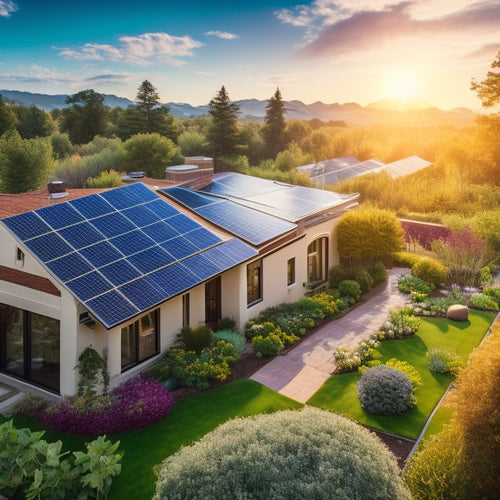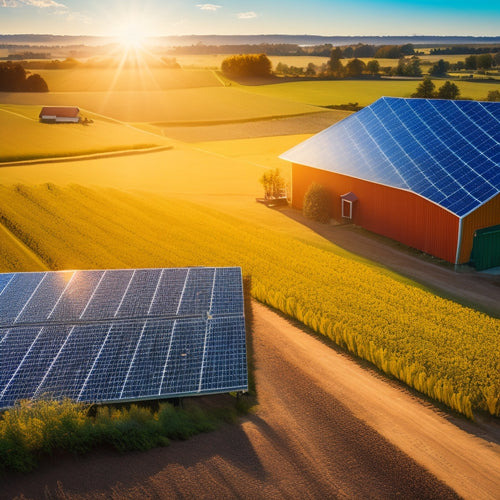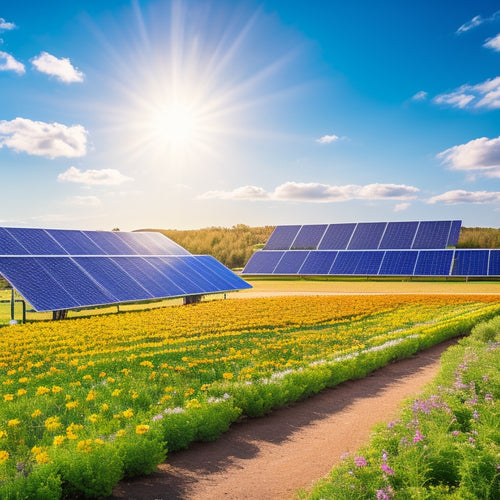
How to Install My Own Solar Panels
Share
When installing your own solar panels, you'll need to choose the right equipment, considering factors like monocrystalline, polycrystalline, or thin-film panels, and evaluating wattage and temperature coefficient. Next, prepare your roof and site by reviewing its condition, evaluating site orientation, and identifying potential obstructions. Secure roof anchors, use high-quality materials, and determine the installation technique for the mounting system. Then, connect the solar panels, arranging them for ideal orientation, and following wiring requirements and manufacturer specifications. Finally, conduct a thorough inspection and testing to guarantee a safe and efficient system - and that's just the starting point for a successful DIY solar panel installation.
Key Takeaways
- Assess your roof's condition, orientation, and potential obstructions to ensure a suitable installation site.
- Choose the right solar panels based on efficiency, wattage, and temperature coefficient to meet your energy needs.
- Securely install a mounting system with high-quality materials, following manufacturer instructions and local building codes.
- Connect solar panels in series with MC4 connectors, ensuring optimal orientation, wiring, and voltage/current ratings.
- Conduct a thorough final inspection and testing, including safety tests and multimeter measurements, to validate system operation.
Choosing the Right Solar Panels
When shopping for solar panels, you're faced with numerous options, each boasting unique features and benefits. To make an informed decision, you need to understand the different solar panel types and their efficiency ratings.
Monocrystalline silicon panels offer high efficiency ratings, typically above 20%, but come at a higher cost. Polycrystalline silicon panels are a more affordable option, with efficiency ratings ranging from 15% to 17%. Thin-film panels are the most budget-friendly option, but their efficiency ratings are lower, typically below 15%.
You'll also need to evaluate the panel's wattage, which affects the overall power output. Look for panels with high wattage per hour to maximize energy production. Additionally, check the panel's temperature coefficient, as high temperatures can reduce efficiency.
Preparing Your Roof and Site
Your roof and surrounding site play a critical role in guaranteeing a successful solar panel installation. Before you begin, it's crucial to assess your roof's condition to verify it can support the weight of the solar panels. Check for signs of wear, damage, or aging, and consider repairing or replacing it if necessary.
Additionally, evaluate the site orientation to determine the best placement of your solar panels. A south-facing roof with little to no shade is ideal, but you can still achieve decent results with east- or west-facing roofs.
Take note of any potential obstructions, such as trees, chimneys, or vents, that could cast shade on your solar panels. Trim trees or relocate vents to maximize sunlight exposure.
Also, consider the roof's pitch and verify it's compatible with your chosen solar panel system. A steeper pitch may require specialized mounting hardware, adding complexity and cost to your installation.
Installing the Mounting System
Installing the Mounting System
Secure the roof anchors to confirm a sturdy foundation for your solar panel system. This is a critical step, as it will support the weight of your panels and withstand various environmental conditions. Verify you're using high-quality mounting materials that meet local building codes and regulations.
Next, determine the best installation technique for your roof type. You may need to use flashings, sealants, or specialized fasteners to guarantee a watertight seal. Consult local experts or online resources if you're unsure about the best approach for your specific situation.
| Mounting Material | Roof Type | Installation Technique |
|---|---|---|
| Rail-based system | Asphalt shingle | Flashing and sealant |
| Clamping system | Metal roof | Specialized fasteners |
| Ballasted system | Flat roof | Weight-based anchoring |
| Hybrid system | Tile roof | Combination of flashing and clamping |
Remember to always follow manufacturer instructions and local regulations when installing the mounting system. Proper installation will confirm a safe and efficient solar panel system that generates maximum power for your home.
Connecting the Solar Panels
The solar panels themselves must now be connected to form a cohesive unit. This involves carefully arranging the panels in a specific orientation to maximize energy output.
Consider the angle and direction of the sun in your location to determine the best panel orientation. Typically, a south-facing orientation with a tilt between 30-40 degrees is ideal.
Next, you'll need to connect the panels using wiring techniques that minimize energy loss. Use MC4 connectors to link the panels in a series, guaranteeing that the positive terminal of one panel is connected to the negative terminal of the next. This creates a continuous flow of energy through the system.
Be sure to follow the manufacturer's instructions for specific wiring requirements, as they may vary. As you connect the panels, pay attention to the voltage and current ratings of each component.
Verify that the wiring and connectors can handle the maximum output of the system. Finally, use weather-resistant wiring and connectors to protect the system from the elements.
Final Inspection and Testing
Before flipping the switch on your newly installed solar panel system, conduct a thorough inspection to verify everything is in order.
Check the entire system, from the panels to the inverter and electrical connections, for any signs of damage or wear. Confirm all cables are securely fastened, and connectors are tightened properly. Verify that all electrical components are rated for outdoor use and meet local regulations.
Next, perform a series of safety tests to confirm the system operates within safe voltage and current limits.
Use a multimeter to measure voltage, current, and power output. Compare these readings to the manufacturer's specifications to validate they're within tolerance.
Also, test the system's grounding and bonding connections to verify they're secure and meet safety protocols.
Frequently Asked Questions
Can I Install Solar Panels on a Metal or Flat Roof?
You can install solar panels on a metal or flat roof, but consider specific requirements for metal roof installation, such as securing panels with clamps or brackets, and for flat roof considerations, like ensuring waterproofing and structural integrity.
Do I Need a Building Permit for Solar Panel Installation?
Are you prepared to maneuver through the red tape? You'll likely need a building permit for solar panel installation, so research local regulations to determine requirements and factor in permit costs, which vary by jurisdiction.
How Long Does a Typical Solar Panel Installation Take?
You'll find that a typical solar panel installation takes around 3-5 days, but the installation timeline can vary depending on installation factors such as roof complexity, system size, and local labor efficiency.
Can I Expand My Solar Panel System in the Future?
You can easily expand your solar panel system in the future by adding more panels to increase solar panel capacity or integrating energy storage options, like batteries, to optimize your energy independence and reduce grid reliance.
Will Solar Panels Void My Roof's Warranty?
When you install solar panels, you'll need to review your roof's warranty to guarantee it won't be voided; consider roof warranty considerations, as they may impact your resale value, and consult with your roofing contractor to mitigate any potential issues.
Conclusion
Now that you've completed the installation, you're utilizing the sun's energy like a pro! Think of it like sailing a boat - you've charted your course, steered through the installation process, and finally, you're reaping the rewards. In fact, did you know that a typical solar panel system can save homeowners up to $500 per year on their electricity bills? Congratulations, you're now sailing smoothly towards a more sustainable future!
Related Posts
-

Sustainable Solar Energy for Cost-Effective Living
Adopting sustainable solar energy isn't just eco-friendly; it's a smart financial strategy. You'll slash your monthly...
-

Off-Grid Solar Solutions for Sustainable Farming
Off-grid solar solutions can revolutionize your farming operations by providing energy independence and significant c...
-

High-Performance Solar Solutions for Sustainable Living
High-performance solar solutions are your gateway to sustainable living, maximizing energy efficiency while considera...


